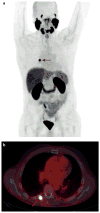Oligometastatic prostate cancer: definitions, clinical outcomes, and treatment considerations
- PMID: 27725639
- PMCID: PMC5808411
- DOI: 10.1038/nrurol.2016.175
Oligometastatic prostate cancer: definitions, clinical outcomes, and treatment considerations
Abstract
The oligometastatic state has been proposed as an intermediate stage of cancer spread between localized disease and widespread metastases. With improvements in diagnostic modalities such as functional imaging, oligometastatic prostate cancer is being diagnosed with greater frequency than ever before. Furthermore, the paradigm for treatment of advanced prostate cancers is shifting toward a more aggressive approach. Many questions surround the understanding of the process and consequences of oligometastasis, meaning that the contemporary literature offers a wide variety of definitions of oligometastatic prostate cancer. Until genomic data exist to provide a biological component to the definition of oligometastatic disease, a clinical diagnosis made on the basis of up to five extrapelvic lesions is reasonable for use. Retrospective studies suggest that interventions such as radical prostatectomy and local or metastasis-directed radiotherapy can be performed in the metastatic setting with minimal risk of toxic effects. These therapies seem to decrease the need for subsequent palliative interventions, but insufficient data are available to draw reliable conclusions regarding their effect on survival. Thus, a protocol for clinicians to manage the patient presenting with oligometastatic prostate cancer would be a useful clinical tool.
Conflict of interest statement
The authors declare no competing interests.
Figures


References
-
- Hellman S, Weichselbaum RR. Oligometastases. J Clin Oncol. 1995;13:8–10. - PubMed
-
- Vogelstein B, Kinzler KW. The multistep nature of cancer. Trends Genet. 1993;9:138–141. - PubMed
-
- Rinker-Schaeffer CW, Partin AW, Isaacs WB, Coffey DS, Isaacs JT. Molecular and cellular changes associated with the acquisition of metastatic ability by prostatic cancer cells. Prostate. 1994;25:249–265. - PubMed
-
- Weichselbaum RR, Hellman S. Oligometastases revisited. Nat Rev Clin Oncol. 2011;8:378–382. - PubMed
-
- Pastorino U, et al. Long-term results of lung metastasectomy: prognostic analyses based on 5206 cases. J Thorac Cardiovasc Surg. 1997;113:37–49. - PubMed
Publication types
MeSH terms
Grants and funding
LinkOut - more resources
Full Text Sources
Other Literature Sources
Medical

